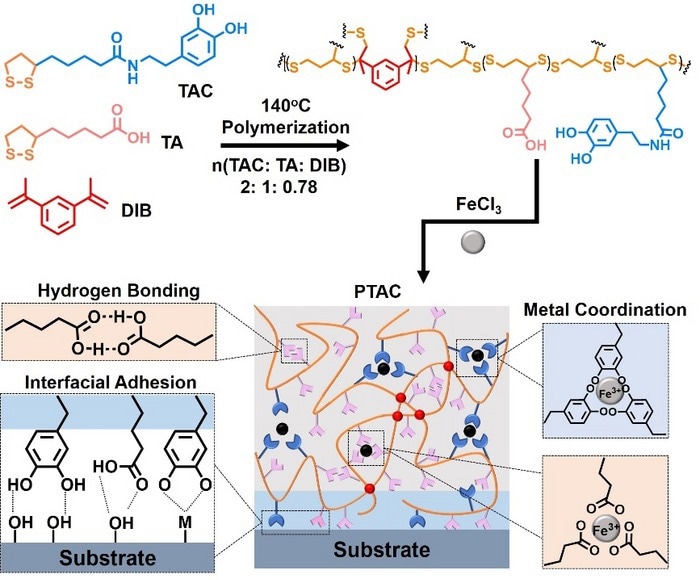DOPA chemistry, which is important in adhesive proteins and inspired by mussels’ exceptional underwater adhesion ability, has developed into a typical supramolecular toolbox for developing water-resistant adhesive materials, leading to attractive development based on the framework of (hydro)gels.

Schematic representation of the monomer structures, synthesis conditions and polymer networks (top), and the cohesive networks and interface adhesion mechanism of the PTAC copolymer (bottom). Image Credit: Science China Press
The DOPA-functionalized solvent-free network, which could strengthen the supramolecular binding of DOPA moieties to the surface by eliminating solvation competition and further improve the material performance of the bio-inspired adhesive material, has, however, received relatively little attention from studies.
Thioctic acid (TA), a naturally occurring small molecule, was used as the feedstock to create several solvent-free supramolecular networks by Professors Da-hui Qu and He Tian from the East China University of Science and Technology.
Together, the non-covalent sidechain crosslinking and the reversible ring-opening polymerization (ROP) mediated by dynamic covalent disulfide bonds endow the resulting network with a variety of fascinating dynamic functions, such as mechanical adaptability, self-healing capacity, reprocessability, and chemical closed-loop recyclability.
The resulting polymeric materials also exhibit outstanding adhesive capabilities, which can be attributed to (i) the small-molecule precursor’s strong interfacial penetration, (ii) the carboxylic sidechain’s high abundance of hydrogen bonds, and (iii) the network’s solvent-free nature.
Due to this character trait, scientists thought it would be exciting to combine the benefits of both adhesion chemistries in a single material that is a high-strength adhesive while also being water-resistant, durable, and dynamic by introducing mussel-inspired DOPA chemistry into the solvent-free network of poly (TA).
Here, researchers describe a strong underwater adhesive material that combines dynamic polymers based on TA with adhesion chemistry derived from mussels. The copolymer network of TA and TAC can be easily synthesized and regulated by one-pot solvent-free ROP by adding a catechol unit to the TA sidechain.
The improved supramolecular network demonstrates high-strength adhesion capability (shear strength >11 MPa) and dynamic features.
Excellent durability, reusability, and water resistance are displayed by the strong interfacial adhesion. It is possible that the hydrophobic yet polar PTAC network may cause interfacial water replacement upon adhesion, resulting in strong underwater adhesion, given the remarkable ability of the interfacial adhesion to resist water.
The measurements of the contact angles between molten PTAC copolymer and water on various substrates provide evidence in favor of this idea. Additionally, this design strategy and the materials it is associated with will present numerous options in the development and use of wearable electronics and bio-adhesive materials due to the biocompatibility of TA and the dynamic properties of the material.
Journal Reference:
Shi, C-Y., et al. (2022) Robust and dynamic underwater adhesives enabled by catechol-functionalized poly(disulfides) network. National Science Review. doi:10.1093/nsr/nwac139